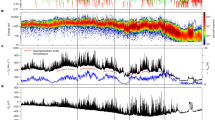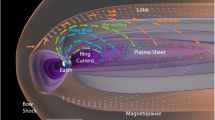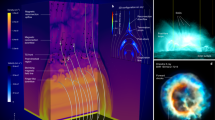Abstract
Rotating at over twice the angular speed of Earth, Saturn imposes a rapid spin on its magnetosphere. As a result, cold, dense plasma is believed to be flung outward from the inner magnetosphere by centrifugal force and replaced by hotter, more tenuous plasma from the outer magnetosphere. The centrifugal interchange1 of plasmas in rotating magnetospheres was predicted many years ago2,3,4 and was conclusively demonstrated by observations in Jupiter’s magnetosphere5,6,7, which—like that of Saturn (but unlike that of Earth)—is rotationally dominated. Recent observations in Saturn’s magnetosphere8,9,10 have revealed narrow injections of hot, tenuous plasma believed to be the inward-moving portion of the centrifugal interchange cycle. Here we report observations of the distribution of the angle between the electron velocity vector and the magnetic field vector (‘pitch angle’) obtained in the cold, dense plasma adjacent to these inward injection regions. The observed pitch-angle distributions are indicative of outward plasma flow and consistent with centrifugal interchange in Saturn’s magnetosphere. Further, we conclude that the observed double-peaked (‘butterfly’) pitch-angle distributions result from the transport of plasma from regions near the orbits of Dione and Tethys, supporting the idea of distinct plasma tori associated with these moons11,12,13.
This is a preview of subscription content, access via your institution
Access options
Subscribe to this journal
Receive 51 print issues and online access
$199.00 per year
only $3.90 per issue
Buy this article
- Purchase on Springer Link
- Instant access to full article PDF
Prices may be subject to local taxes which are calculated during checkout




Similar content being viewed by others
References
Kruskal, M. D. & Schwarzschild, M. Some instabilities of a completely ionized plasma. Proc. R. Soc. Lond. A 223, 348–360 (1954)
Michel, F. C. & Sturrock, P. A. Centrifugal instability of the jovian magnetosphere and its interaction with the solar wind. Planet. Space Sci. 22, 1501–1510 (1974)
Hill, T. W. Interchange stability of a rapidly rotating magnetosphere. Planet. Space Sci. 24, 1151–1154 (1976)
Pontius, D. H., Hill, T. W. & Rassbach, M. E. Steady state plasma transport in a corotation-dominated magnetosphere. Geophys. Res. Lett. 13, 1097–1100 (1986)
Bolton, S. J. et al. Enhanced whistler-mode emissions: signatures of interchange motion in the Io torus. Geophys. Res. Lett. 24, 2123–2126 (1997)
Thorne, R. M. et al. Galileo evidence for rapid inward transport in the Io torus. Geophys. Res. Lett. 24, 2131–2134 (1997)
Frank, L. A. & Paterson, W. R. Observations of plasmas in the Io torus with the Galileo spacecraft. J. Geophys. Res. 105, 16,017–16,034 (2000)
Burch, J. L. et al. Properties of local plasma injections in Saturn’s magnetosphere. Geophys. Res. Lett. 32 L14S02 doi: 10.1029/2005GL022611 (2005)
Hill, T. W. et al. Evidence for rotationally driven plasma transport in Saturn’s magnetosphere. Geophys. Res. Lett. 32 L14S10 doi: 10.1029/2005GL022620 (2005)
Mauk, B. H. et al. Energetic particle injections in Saturn’s magnetosphere. Geophys. Res. Lett. 32 L14S05 doi: 10.1029/2005GL022485 (2005)
Frank, L. A. et al. Plasma in Saturn’s magnetosphere. J. Geophys. Res. 85, 5695–5708 (1980)
Richardson, J. D., Eviatar, A. & Siscoe, G. L. Satellite tori at Saturn. J. Geophys. Res. 91, 8749–8755 (1986)
Wahlund, J.-E. et al. The inner magnetosphere of Saturn: Cassini RPWS cold plasma results from the first encounter. Geophys. Res. Lett. 332 L20S09 doi: 10.1029/2005GL022699 (2005)
Thorne, R. M., Williams, D. J., Zhang, L. D. & Stone, S. Energetic electron butterfly distributions near Io. J. Geophys. Res. 104, 14755–14766 (1999)
Rymer, A. M. et al. Electron sources in Saturn’s magnetosphere. J. Geophys. Res. 112 A02201 doi: 10.1029/2006JA013017 (2007)
Connerney, J. E. P., Ness, N. F. & Acuna, M. H. Zonal harmonic model of Saturn’s magnetic field from Voyager 1 and 2 observations. Nature 298, 44–46 (1982)
Alexeev, I. I. et al. A global magnetic model of Saturn's magnetosphere and a comparison with Cassini SOI data. Geophys. Res. Lett. 33 L08101 doi: 10.1029/2006GL025896 (2006)
André, N. Magnetic signatures of plasma-depleted flux tubes in the Saturnian inner magnetosphere. Geophys. Res. Lett. (submitted)
Sittler, E. C., Ogilvie, K. W. & Scudder, J. D. Survey of low-energy plasma electrons in Saturn’s magnetosphere: Voyagers 1 and 2. J. Geophys. Res. 88, 8847–8870 (1983)
Sittler, E. C. et al. Cassini observations of Saturn’s inner plasmasphere: Saturn orbit insertion results. Planet. Space Sci. 54, 1197–1210 (2006)
Acknowledgements
We gratefully acknowledge comments by F. Crary, B. Mauk, E. Sittler, M. Thomsen, T. Hill, and H. Waite.
Author Contributions J.L.B. developed the interpretation of the Cassini data and is lead author of this paper. J.G. and W.S.L. were responsible for data analysis and, respectively, for figure preparation and preparation of the text. D.T.Y, A.J.C. and M.K.D. are, respectively, the CAPS principal investigator, the CAPS Electron Spectrometer lead and the Cassini MAG principal investigator, and provided both data and analysis. N.A. contributed to the data analysis and modelling.
Author information
Authors and Affiliations
Corresponding author
Ethics declarations
Competing interests
Reprints and permissions information is available at www.nature.com/reprints. The authors declare no competing financial interests.
Supplementary information
Supplementary Information
This file contains Supplementary Figures 1-3, including illustrative sketch and Supplementary Discussion with detail of pitch angle production and critical pitch angle effect in outflowing plasma. (PDF 1283 kb)
Rights and permissions
About this article
Cite this article
Burch, J., Goldstein, J., Lewis, W. et al. Tethys and Dione as sources of outward-flowing plasma in Saturn’s magnetosphere. Nature 447, 833–835 (2007). https://doi.org/10.1038/nature05906
Received:
Accepted:
Issue Date:
DOI: https://doi.org/10.1038/nature05906
This article is cited by
-
1. Transport of Mass, Momentum and Energy in Planetary Magnetodisc Regions
Space Science Reviews (2015)
-
Extreme Ultraviolet Radiation Measurement for Planetary Atmospheres/Magnetospheres from the Earth-Orbiting Spacecraft (Extreme Ultraviolet Spectroscope for Exospheric Dynamics: EXCEED)
Space Science Reviews (2014)
-
Mapping Magnetospheric Equatorial Regions at Saturn from Cassini Prime Mission Observations
Space Science Reviews (2011)
-
Volcanism in the Solar System
Nature Geoscience (2009)
Comments
By submitting a comment you agree to abide by our Terms and Community Guidelines. If you find something abusive or that does not comply with our terms or guidelines please flag it as inappropriate.



